If you’re looking for ways to lose belly fat, you’ve come to the right place. Slimming down an overgrown midsection requires a dedicated combo of regular physical activity, healthy eating habits, and tweaks to your daily lifestyle.
Not only is excess belly fat frustrating to deal with on a daily basis, but beyond aesthetics, abdominal fat—or the “visceral fat” tucked away in your belly and surrounds your organs—can be detrimental to your health. In fact, research shows that having too much visceral fat can increase your risk of developing heart disease, among other chronic health concerns.
“Visceral fat should only make up 10% of your body fat,” explains Lisa Young, Ph.D., RDN, the author of Finally Full, Finally Slim, a nutritionist in private practice and a member of our Medical Expert Board. “This type of fat is particularly harmful, as high levels can increase the risk of heart disease, type 2 diabetes, and high cholesterol. Fortunately, [visceral fat metabolizes] quicker with a healthy lifestyle, although maintaining a diet and exercise plan to see full results can be challenging.”
Although the journey can be difficult at times, that should not deter you from sculpting an all-around fitter, leaner you. Note that losing your belly is the first half of the journey—keeping it off means sticking to and being consistent with these healthier lifestyle choices.
Now, let’s dive into the top ways to lose belly fat, according to experts.
What Is Belly Fat?


The issue with belly fat is it’s not just what you see on the outside—there are multiple layers to it.
“Subcutaneous fat is the fat stored under your skin, which you can pinch,” explains Young. “In contrast, visceral fat is stored deep within the organs surrounding your heart, stomach, liver, and intestines, and it is not visible from the outside.”
Having too much belly fat can result in a myriad of health issues that shouldn’t be taken lightly, such as heart disease, high blood pressure, high blood sugar, sleep apnea, fatty liver, and certain cancers.
How to Lose Belly Fat
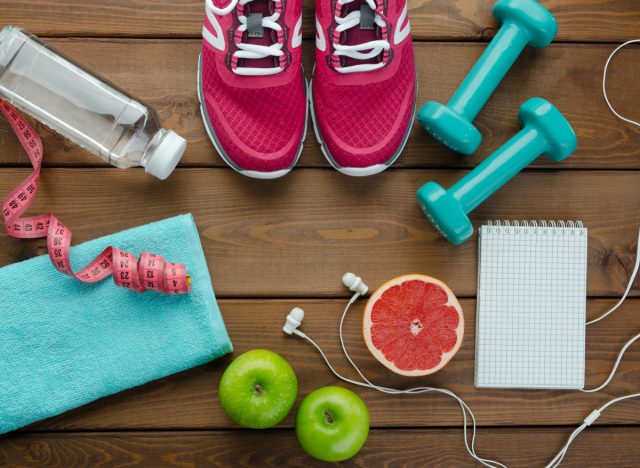

In this section, we outline 10 effective ways to lose belly fat, categorized by diet, exercise, and lifestyle modifications, to help you achieve a healthier and leaner midsection.
Optimize your diet
Eat enough protein.
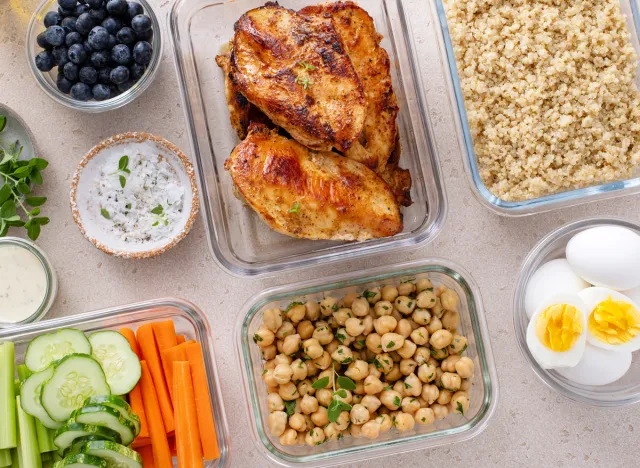

Tweaking your diet means making sure you’re getting enough protein. According to 2015 research published in The American Journal of Clinical Nutrition, following a high-protein diet is an excellent way to lose weight—including in your belly. Consumption of high-protein foods such as eggs, Greek yogurt, beans, chicken breast, tuna, quinoa, and salmon can aid your belly fat-loss efforts and help you avoid further accumulation of abdominal fat.
“Eating protein increases satiety and reduces overall calorie intake, preventing overeating and excess belly fat. Furthermore, protein consumption plays a role in hormone regulation by reducing cravings and promoting appetite control,” says Young.
Fill up on fiber.
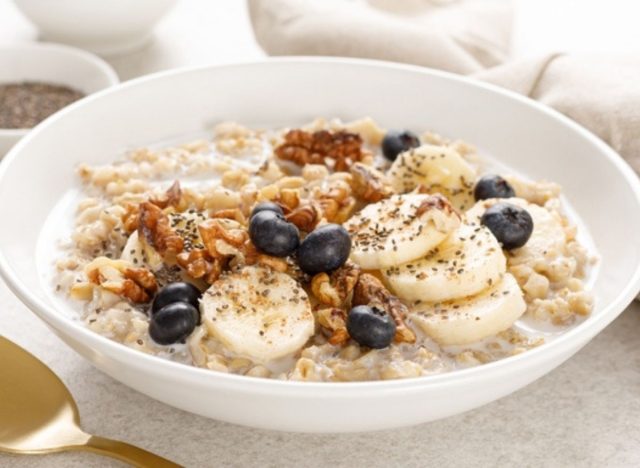

As for fiber, research published in The Journal of Clinical Endocrinology & Metabolism indicates that bumping up your fiber consumption is linked to a reduction in visceral fat.
“Fiber plays a role in promoting a healthy gut and reducing inflammation, which decreases the risk of developing visceral fat,” Young explains.
Some high-fiber foods that’ll support your weight-loss efforts include chia seeds, lentils, raspberries, artichokes, collard greens, and sweet potatoes with the skin. According to the Academy of Nutrition and Dietetics, women should strive to consume 25 grams of fiber daily, and men should consume 38 grams of fiber daily (or 14 grams per every 1,000 calories consumed).
Ditch the sugar.
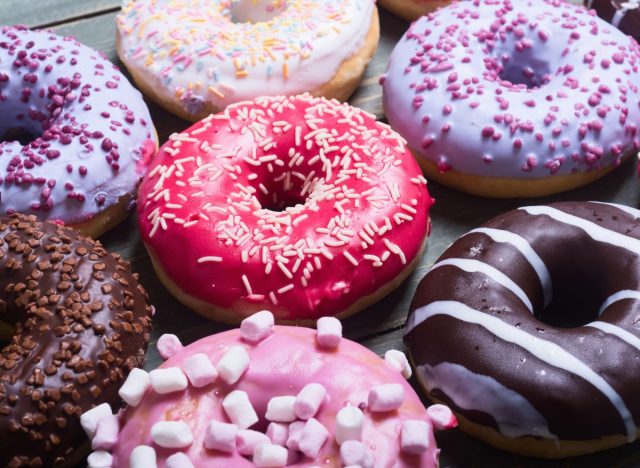

Ice cream, chocolate chip cookies, doughnuts, and pastries sure do taste delicious, but these sugar-filled treats are void of nutrients and aren’t doing your waistline any favors. In fact, research published in The Journal of Nutrition shows that sugar-sweetened beverages, for instance, are directly linked to increased visceral fat.
“Reduce [your] consumption of sugary foods as they are calorie-dense and can contribute to the accumulation of fat in the abdominal area,” Young explains. “Sugary foods increase insulin levels, promoting fat storage, specifically in the belly. [In addition,] high sugar intake plays a role in inflammation, as it is associated with insulin resistance and metabolic disorders. Fructose is often present in sugary foods, which increases the production of triglycerides, a type of fat that accumulates in the abdominal area.”
Consider opting for sugar alternatives like monk fruit and stevia and reducing your overall sugar intake. Swap out soda for seltzer or fruit-infused water. In addition, choose whole foods such as fresh veggies and fruits, whole-grain breads, and lean meats.
“Cooking more at home can [also help you] avoid processed foods and added sugars, giving you full control over the ingredients,” Young adds.
Stay away from trans fat.
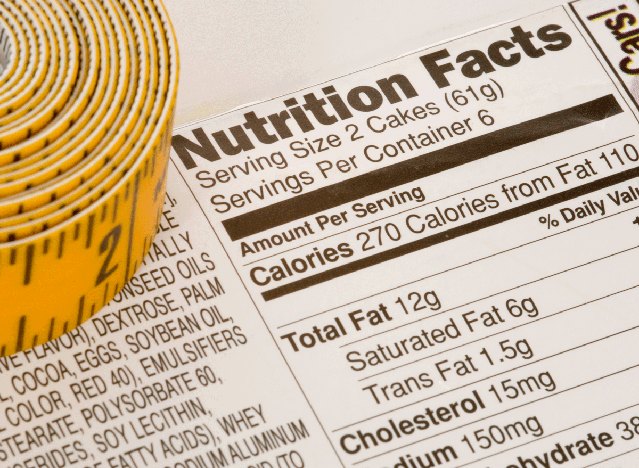

Trans fats are bursting with calories and can cause weight gain in your stomach, resulting in a greater amount of visceral fat when consumed in excess, Young points out. They also promote inflammation and an increase in LDL cholesterol, a surefire recipe for belly fat. Research published in Obesity directly correlates the consumption of trans fats to abdominal fat.
Avoid trans fats, which can be found in fried foods (such as French fries), snack foods (like chips), and processed items (such as margarine) at all costs. Choose healthier unsaturated fats like avocado, nuts, peanut butter, fatty fish, and olive oil instead.
Make sure your plate is well-balanced.
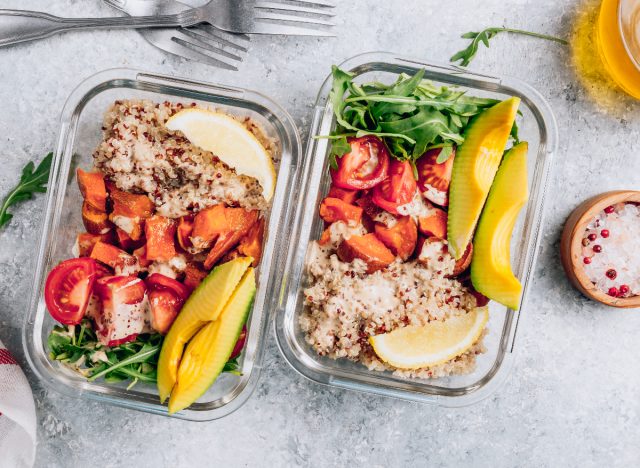

If you want to sculpt a leaner midsection, Amy Goodson, MS, RD, CSSD, LD, a registered dietitian and certified specialist in sports dietetics who sits on our Medical Expert Board, recommends balancing your plate.
“Focus on consuming nutrient-rich foods like lean protein, whole grains, fruit, vegetables, and healthy fat 80 to 90% of the time,” Goodson says. “Then, save 10 to 20% for fun foods that likely shouldn’t be on your plate every day like foods with added sugar, fried foods, sugar-sweetened beverages, and desserts.”
This is a smart eating habit to get into, as it can help you establish a calorie deficit, which will result in total body fat loss. Plus, research shows that consuming a well-balanced diet can help you lose weight, which, in turn, helps you melt belly fat.
In addition, consider portion control. “The primary cause of weight/body fat gain is excessive caloric intake,” explains Lacy Puttuck, MS, RDN, CISSN, CSCS, from Top Nutrition Coaching. “This is where portion sizes are important. Making sure portion sizes are appropriate is the primary way to cut back on calories. Using a food diary and measuring foods can be a great strategy to ensure your portions are correct for you and your caloric goals.”
Engage in Regular Exercise
Incorporate cardio into your workout routine.


Now is the best time to kick up your cardio game. Consider working regular cardio exercise into your routine, as aerobic exercises like jogging, swimming, brisk walking, hiking, plogging, treadmill workouts, or even dancing can decrease visceral fat—research says so!
“Aim for at least 150 minutes of moderate-intensity activity or 75 minutes of high-intensity activity every week,” Goodson instructs. “And better yet, if you can intertwine interval training, do it! This type of training typically burns more calories in a shorter period of time. Cardio activity helps burn calories to help reduce overall body and belly fat.”
And, if you’re low on motivation, it’s always a great idea to recruit an exercise buddy, sign up for an at-home fitness program you know you’ll stick with, or find ways to stay entertained while on walks, like a good playlist, audio book, or podcast.
Perform HIIT.


While we’re at it, let’s chat about high-intensity interval training (HIIT). According to Tyler Read, the founder of PTPioneer.com, HIIT is an excellent way to get your health back on track. Research shows that HIIT can help you lose weight and shrink your belly.
“HIIT involves quick and very intense bursts of activity,” Read says. “It can burn a lot of calories in a short time, and studies have shown that it can be effective at reducing belly fat. An example of a HIIT workout might involve alternating between 30 seconds of sprinting and 30 seconds of walking, repeated for 10 to 20 minutes.”
If you’re just starting out with this form of training, don’t feel intimidated. Some beginner-friendly HIIT exercises include working with battle ropes, cycling on an air bike, performing sliding mountain climbers, using the rowing machine, and jumping rope.
Strength train.


Resistance training, aka strength training, is something Goodson and Read both stress the importance of. It’s necessary to establish a healthy balance of cardio and strength training within your workouts. Plus, research shows that strength training can help decrease visceral fat, body fat percentage, and body fat mass.
“Strength training actually helps keep your metabolism elevated longer throughout the day, plus it helps build muscle,” Goodson explains. “An elevated metabolism can help increase the amount of calories you burn over the course of the day leading to greater caloric deficit.”
When you have the goal of losing weight and belly fat, we recommend performing the following strength training exercises:
-
- Squats: (three sets of 12 to 15 reps)
- Deadlifts: (three sets of 10 to 12 reps)
- Pushups (three sets of 15 to 20 reps)
- Pull-ups (as many reps as possible)
- Lunges (three sets of 12 reps on each leg)
- Bench presses (three sets of 10 to 12 reps)
- Planks (hole for 30 to 60 seconds)
- Russian twists (three sets of 20 twists, 10 per side)
- Bent-over rows (three sets of 12 to 15 reps)
- Mountain climbers (three sets of 20 reps, 10 per leg)
Lifestyle Modifications
Manage Stress Effectively


Not only can chronic stress promote the accumulation of fat around your waistline due to a jump in cortisol levels, but it can also be a killer.
“Managing stress is paramount to managing body fat and belly fat,” explains Puttuck. “There is a link between high stress and the accumulation of body fat. The elevation cortisol can also increase cravings for unhealthy foods, which [can] also lead to accumulation of belly fat.”
Goodson suggests adding stress-reducing activities to your routine, such as yoga, deep breathing exercises, meditation, and/or carving out time for the hobbies you love most. Starting the morning off with mindful activities like writing in a gratitude journal and enjoying your favorite cup of tea can also be an excellent way to kick off your day on a positive note. Positive vibes attract positive vibes.
Limit Alcohol Consumption


Sipping cocktails and your favorite wine is a sneaky little way to consume extra unwanted calories. Overdoing it with alcohol can also lead to the accumulation of belly fat.
“Alcohol adds more calories than people think to their eating routine,” Goodson tells us. “Over time, this can lead to weight gain, and often in the abdominal area. And let’s face it—the more you drink, the less you care about what you eat, which can potentially further increase your calorie intake.”
Moral of the story? Drink in moderation. And when you do head out to grab drinks with friends, be mindful of counting your overall calorie intake, or opt for a mocktail instead.
Prioritize Quality Sleep
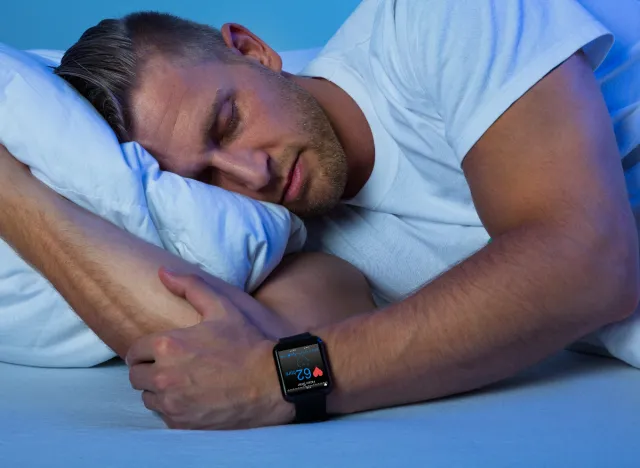

Did you know that how much solid sleep you get can play a critical role in getting rid of belly fat and your overall weight management? Science says that insufficient restful sleep can result in unhealthy belly fat.
“The goal is to get seven to nine hours a night,” Goodson says. “Lack of sleep can lead to disrupted hormones related to appetite regulation, ultimately leading to increased hunger and cravings. When you feel tired, you often look for high-sugar and comfort foods to feel better, which typically have more calories. On the reverse, when you are rested, you are more poised to make better food choices and provide your body with foods that actually give you sustained energy!”
The Sleep Foundation recommends optimizing your bedtime routine to promote relaxation. Habits like dimming the light in your bedroom, powering down blue light devices, trying breathing exercises or calming yoga stretches, reading a book or streaming light music before nodding off can make a major difference.
Conclusion:


When it comes down to it, losing belly fat and keeping it off is a lifestyle; it requires hard work, dedication, and adopting healthy diet and exercise habits. Sticking to this routine can help you achieve the midsection you desire while promoting overall better mental and physical health.
A version of this story was originally published in July 2023. It has been updated to include new information.


